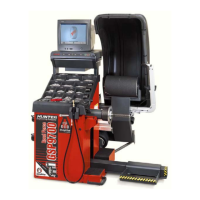GSP9700 Series Road Force Measurement System Operation 2. Balancing Overview 15
2. Balancing Overview
2.1 Balancing Modes
SmartWeight™ Balancing Technology
SmartWeight™ balancing technology is a method of reducing forces on a wheel
during balancing. This results in less weight used, and less time balancing tires.
SmartWeight is not a procedure. Instead, it measures the forces of side-to-side
shimmy and up-and-down shake and computes weight to reduce these forces. This
reduces the amount of weight, reduces time, reduces check spins and chasing
weights, and saves the shop time and money.
SmartWeight can reduce the number of steps in the balancing process.
Balancing Theory
Static Imbalance
As the word static implies, the tire will be balanced when at rest. For example, if an
unmoving assembly was centered on a cone and was balanced, it would be statically
balanced. A “bubble balancer” is designed to statically balance a tire/wheel
assembly.
IMBALANCE
FORCE
FRONT VIEW
STATIC IMBALANCE
CUPPING
Static imbalance is where there is one amount of weight located in the center of the
tire/wheel assembly causing an imbalance. As the weight rotates, centrifugal forces
are created causing the wheel to lift as the weight reaches top dead center. This
lifting motion causes the tire/wheel assembly to move “up and down” creating a
bounce to be felt. This static imbalance condition is evident by a “jiggle” or up-down
movement of the steering wheel. These vibrations may also be apparent in the body,
with or without steering wheel shake.
A statically imbalanced tire driven for an extended period may cause “cupping” in the
tire’s tread, create vibration, and adversely effect handling.

